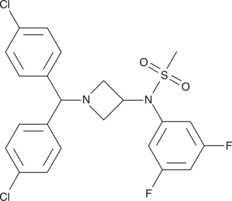Chemicals
Showing 10351–10500 of 41137 results
-
Aurintricarboxylic acid (ATA) is an inhibitor of protein synthesis that has diverse biological activities.{54334,54335,54336,54337,54338,54339,54340,54341} It inhibits the activity of a variety of enzymes, including the nucleases DNase I, RNase A, and S1, as well as the serine proteases trypsin and chymotrypsin in a concentration-dependent manner.{54335,54336} ATA inhibits replication of severe acute respiratory syndrome coronavirus (SARS-CoV; EC50 = 200 µg/ml) and human enterovirus 71 in Vero cells (EV71; EC50 = 2.9 µM), as well as reduces HIV-1- or HIV-2-induced cytopathogenicity in MT-4 cells (IC50s = 1.1 and 0.85 µg/ml, respectively).{54337,54338,54339} It inhibits apoptosis induced by sanguinarine (Item No. 16951) in K562 leukemia cells when used at a concentration of 100 µM.{54340} ATA (20 mg/kg, i.p.) decreases CNS CD4+ T cell infiltration and reduces hind limb weakness and paralysis in a mouse model of myelin oligodendrocyte glycoprotein-induced experimental autoimmune encephalomyelitis (EAE).{54341}
Brand:CaymanSKU:30636 - 50 gAvailable on backorder
Aurodox is a polyketide antibiotic originally isolated from S. goldiniensis.{42705} It is active against Gram-positive bacteria, including B. megaterium, B. anthracis, and M. hominis (MICs = 0.06, 0.6, and 3-10 µg/ml, respectively), as well as Pneumococcus and Streptomyces species (MICs = 3-12 and 3-30 µg/ml, respectively). It is effective against S. pyogenes infection in mice with a 50% curative dose (CD50) value of 71 mg/kg. Aurodox inhibits bacterial protein synthesis by binding to bacterial elongation factor Tu (EF-Tu) and inhibiting its release from the ribosome.{42706,42707}
Brand:CaymanSKU:27584 - 1 mgAvailable on backorder
Aurodox is a polyketide antibiotic originally isolated from S. goldiniensis.{42705} It is active against Gram-positive bacteria, including B. megaterium, B. anthracis, and M. hominis (MICs = 0.06, 0.6, and 3-10 µg/ml, respectively), as well as Pneumococcus and Streptomyces species (MICs = 3-12 and 3-30 µg/ml, respectively). It is effective against S. pyogenes infection in mice with a 50% curative dose (CD50) value of 71 mg/kg. Aurodox inhibits bacterial protein synthesis by binding to bacterial elongation factor Tu (EF-Tu) and inhibiting its release from the ribosome.{42706,42707}
Brand:CaymanSKU:27584 - 5 mgAvailable on backorder
Aurodox is a polyketide antibiotic originally isolated from S. goldiniensis.{42705} It is active against Gram-positive bacteria, including B. megaterium, B. anthracis, and M. hominis (MICs = 0.06, 0.6, and 3-10 µg/ml, respectively), as well as Pneumococcus and Streptomyces species (MICs = 3-12 and 3-30 µg/ml, respectively). It is effective against S. pyogenes infection in mice with a 50% curative dose (CD50) value of 71 mg/kg. Aurodox inhibits bacterial protein synthesis by binding to bacterial elongation factor Tu (EF-Tu) and inhibiting its release from the ribosome.{42706,42707}
Brand:CaymanSKU:27584 - 500 µgAvailable on backorder
Aurora A inhibitor I is a potent and selective inhibitor of Aurora A kinase (IC50s = 3.4 and 3,400 nM for Aurora A and Aurora B, respectively).{38453} It prevents centrosome separation and reduces phosphorylated Aurora A, but not phosphorylated histone H3, levels at the centrosomes, indicating inhibition is specific to Aurora A kinase. Aurora A inhibitor I reduces the proliferation of HCT116 and HT-29 colorectal carcinoma cells in vitro (IC50s = 0.19 and 2.9 μM, respectively).
Brand:CaymanSKU:21600 -Out of stock
Aurora A inhibitor I is a potent and selective inhibitor of Aurora A kinase (IC50s = 3.4 and 3,400 nM for Aurora A and Aurora B, respectively).{38453} It prevents centrosome separation and reduces phosphorylated Aurora A, but not phosphorylated histone H3, levels at the centrosomes, indicating inhibition is specific to Aurora A kinase. Aurora A inhibitor I reduces the proliferation of HCT116 and HT-29 colorectal carcinoma cells in vitro (IC50s = 0.19 and 2.9 μM, respectively).
Brand:CaymanSKU:21600 -Out of stock
Aurora A inhibitor I is a potent and selective inhibitor of Aurora A kinase (IC50s = 3.4 and 3,400 nM for Aurora A and Aurora B, respectively).{38453} It prevents centrosome separation and reduces phosphorylated Aurora A, but not phosphorylated histone H3, levels at the centrosomes, indicating inhibition is specific to Aurora A kinase. Aurora A inhibitor I reduces the proliferation of HCT116 and HT-29 colorectal carcinoma cells in vitro (IC50s = 0.19 and 2.9 μM, respectively).
Brand:CaymanSKU:21600 -Out of stock
Aurora A inhibitor I is a potent and selective inhibitor of Aurora A kinase (IC50s = 3.4 and 3,400 nM for Aurora A and Aurora B, respectively).{38453} It prevents centrosome separation and reduces phosphorylated Aurora A, but not phosphorylated histone H3, levels at the centrosomes, indicating inhibition is specific to Aurora A kinase. Aurora A inhibitor I reduces the proliferation of HCT116 and HT-29 colorectal carcinoma cells in vitro (IC50s = 0.19 and 2.9 μM, respectively).
Brand:CaymanSKU:21600 -Out of stock
The Aurora kinases are a family of serine/threonine kinases that are key regulators of mitosis and cytokinesis. Aurora kinase inhibitor II is a cell-permeable anilinoquinazoline that blocks the activity of Aurora A (IC50 = 0.39 µM).{29266} In MCF-7 cells, it blocks proliferation with an IC50 value of 1.25 µM.{29266}
Brand:CaymanSKU:-Available on backorder
The Aurora kinases are a family of serine/threonine kinases that are key regulators of mitosis and cytokinesis. Aurora kinase inhibitor II is a cell-permeable anilinoquinazoline that blocks the activity of Aurora A (IC50 = 0.39 µM).{29266} In MCF-7 cells, it blocks proliferation with an IC50 value of 1.25 µM.{29266}
Brand:CaymanSKU:-Available on backorder
The Aurora kinases are a family of serine/threonine kinases that are key regulators of mitosis and cytokinesis. Aurora kinase inhibitor II is a cell-permeable anilinoquinazoline that blocks the activity of Aurora A (IC50 = 0.39 µM).{29266} In MCF-7 cells, it blocks proliferation with an IC50 value of 1.25 µM.{29266}
Brand:CaymanSKU:-Available on backorder
The Aurora kinases are a family of serine/threonine kinases that are key regulators of mitosis and cytokinesis. Aurora kinase inhibitor II is a cell-permeable anilinoquinazoline that blocks the activity of Aurora A (IC50 = 0.39 µM).{29266} In MCF-7 cells, it blocks proliferation with an IC50 value of 1.25 µM.{29266}
Brand:CaymanSKU:-Available on backorder
Aurora kinase inhibitor III is a potent inhibitor of Aurora A kinase (IC50 = 42 nM).{25289} It is selective for Aurora A over BMX, BTK, IGF-1R, c-Src, TRKB, SYK, and EGFR (IC50s = 386, 3,550, 591, 1,980, 2,510, 887, and >10,000 nM, respectively).
Brand:CaymanSKU:21851 -Out of stock
Aurora kinase inhibitor III is a potent inhibitor of Aurora A kinase (IC50 = 42 nM).{25289} It is selective for Aurora A over BMX, BTK, IGF-1R, c-Src, TRKB, SYK, and EGFR (IC50s = 386, 3,550, 591, 1,980, 2,510, 887, and >10,000 nM, respectively).
Brand:CaymanSKU:21851 -Out of stock
Aurora kinase inhibitor III is a potent inhibitor of Aurora A kinase (IC50 = 42 nM).{25289} It is selective for Aurora A over BMX, BTK, IGF-1R, c-Src, TRKB, SYK, and EGFR (IC50s = 386, 3,550, 591, 1,980, 2,510, 887, and >10,000 nM, respectively).
Brand:CaymanSKU:21851 -Out of stock
Australine is a pyrrolizidine alkaloid originally isolated from C. australe that has enzyme inhibitory activities.{54015,54016,54017} It is an inhibitor of glucoamylase (IC50 = 5.8 µM) that also inhibits glucosidase I, sucrase, maltase, and A. niger α-glucosidase (IC50s = 20, 28, 35, and 28 µM, respectively).{54016,54017} Australine is selective for these enzymes over glucosidase II, α- and β-mannosidase, and α- and β-galactosidase up to 500 µM, β-glucosidase, with only 5% inhibition at 66 µM, as well as isomaltase and trehalase (IC50 = 97 and 160 µM, respectively). Australine (500 µg/ml) inhibits glycoprotein processing of viral glycoproteins in influenza virus-infected MDCK cells and induces the accumulation of glycoproteins.{54016}
Brand:CaymanSKU:30051 - 1 mgAvailable on backorder
Australine is a pyrrolizidine alkaloid originally isolated from C. australe that has enzyme inhibitory activities.{54015,54016,54017} It is an inhibitor of glucoamylase (IC50 = 5.8 µM) that also inhibits glucosidase I, sucrase, maltase, and A. niger α-glucosidase (IC50s = 20, 28, 35, and 28 µM, respectively).{54016,54017} Australine is selective for these enzymes over glucosidase II, α- and β-mannosidase, and α- and β-galactosidase up to 500 µM, β-glucosidase, with only 5% inhibition at 66 µM, as well as isomaltase and trehalase (IC50 = 97 and 160 µM, respectively). Australine (500 µg/ml) inhibits glycoprotein processing of viral glycoproteins in influenza virus-infected MDCK cells and induces the accumulation of glycoproteins.{54016}
Brand:CaymanSKU:30051 - 500 µgAvailable on backorder
AUT1 is a positive modulator of the voltage-gated potassium channel subtypes Kv3.1b, Kv3.2a, and Kv3.3 (EC50s = 4.7, 4.9, and 31.6 µM, respectively, in a patch-clamp assay).{46494} It is selective for Kv3.1b, Kv3.2a, and Kv3.3 over Kv1.5 and Kv7.1/minK channels but also inhibits the serotonin (5-HT) transporter, 5-HT3 receptor, and α1 subunit-containing nicotinic acetylcholine receptor (nAChR) in a panel of 26 ion channels, receptors, and transporters. AUT1 increases tetraethylammonium-induced decreases in the firing frequency and amplitude of action potentials in mouse somatosensory cortex slices when used at concentrations of 1 and 10 µM.
Brand:CaymanSKU:28599 - 10 mgAvailable on backorder
AUT1 is a positive modulator of the voltage-gated potassium channel subtypes Kv3.1b, Kv3.2a, and Kv3.3 (EC50s = 4.7, 4.9, and 31.6 µM, respectively, in a patch-clamp assay).{46494} It is selective for Kv3.1b, Kv3.2a, and Kv3.3 over Kv1.5 and Kv7.1/minK channels but also inhibits the serotonin (5-HT) transporter, 5-HT3 receptor, and α1 subunit-containing nicotinic acetylcholine receptor (nAChR) in a panel of 26 ion channels, receptors, and transporters. AUT1 increases tetraethylammonium-induced decreases in the firing frequency and amplitude of action potentials in mouse somatosensory cortex slices when used at concentrations of 1 and 10 µM.
Brand:CaymanSKU:28599 - 100 mgAvailable on backorder
AUT1 is a positive modulator of the voltage-gated potassium channel subtypes Kv3.1b, Kv3.2a, and Kv3.3 (EC50s = 4.7, 4.9, and 31.6 µM, respectively, in a patch-clamp assay).{46494} It is selective for Kv3.1b, Kv3.2a, and Kv3.3 over Kv1.5 and Kv7.1/minK channels but also inhibits the serotonin (5-HT) transporter, 5-HT3 receptor, and α1 subunit-containing nicotinic acetylcholine receptor (nAChR) in a panel of 26 ion channels, receptors, and transporters. AUT1 increases tetraethylammonium-induced decreases in the firing frequency and amplitude of action potentials in mouse somatosensory cortex slices when used at concentrations of 1 and 10 µM.
Brand:CaymanSKU:28599 - 50 mgAvailable on backorder
AUTEN-99 is an inhibitor of the phosphatase myotubularin-related protein 14 (MTMR14/Jumpy).{53584} It inhibits MTMR14/Jumpy activity in a cell-free assay when used at concentrations of 10 and 100 µM. AUTEN-99 (1 and 10 µM) enhances autophagic flux and increases the levels of LC3B-11 in HeLa cells. It increases survival of mouse primary neurons exposed to hydrogen peroxide as a model of oxidative stress when used at concentrations ranging from 0.5 to 5 µM. AUTEN-99 increases the number of autophagic structures in mouse pancreas, kidney, and liver following oral or intraperitoneal administration. It also induces autophagy in the Drosophila larval fat body and increases the percentage of flies climbing a glass column in a climbing assay in a transgenic model of Parkinson’s disease.
Brand:CaymanSKU:30047 - 1 mgAvailable on backorder
AUTEN-99 is an inhibitor of the phosphatase myotubularin-related protein 14 (MTMR14/Jumpy).{53584} It inhibits MTMR14/Jumpy activity in a cell-free assay when used at concentrations of 10 and 100 µM. AUTEN-99 (1 and 10 µM) enhances autophagic flux and increases the levels of LC3B-11 in HeLa cells. It increases survival of mouse primary neurons exposed to hydrogen peroxide as a model of oxidative stress when used at concentrations ranging from 0.5 to 5 µM. AUTEN-99 increases the number of autophagic structures in mouse pancreas, kidney, and liver following oral or intraperitoneal administration. It also induces autophagy in the Drosophila larval fat body and increases the percentage of flies climbing a glass column in a climbing assay in a transgenic model of Parkinson’s disease.
Brand:CaymanSKU:30047 - 10 mgAvailable on backorder
AUTEN-99 is an inhibitor of the phosphatase myotubularin-related protein 14 (MTMR14/Jumpy).{53584} It inhibits MTMR14/Jumpy activity in a cell-free assay when used at concentrations of 10 and 100 µM. AUTEN-99 (1 and 10 µM) enhances autophagic flux and increases the levels of LC3B-11 in HeLa cells. It increases survival of mouse primary neurons exposed to hydrogen peroxide as a model of oxidative stress when used at concentrations ranging from 0.5 to 5 µM. AUTEN-99 increases the number of autophagic structures in mouse pancreas, kidney, and liver following oral or intraperitoneal administration. It also induces autophagy in the Drosophila larval fat body and increases the percentage of flies climbing a glass column in a climbing assay in a transgenic model of Parkinson’s disease.
Brand:CaymanSKU:30047 - 25 mgAvailable on backorder
AUTEN-99 is an inhibitor of the phosphatase myotubularin-related protein 14 (MTMR14/Jumpy).{53584} It inhibits MTMR14/Jumpy activity in a cell-free assay when used at concentrations of 10 and 100 µM. AUTEN-99 (1 and 10 µM) enhances autophagic flux and increases the levels of LC3B-11 in HeLa cells. It increases survival of mouse primary neurons exposed to hydrogen peroxide as a model of oxidative stress when used at concentrations ranging from 0.5 to 5 µM. AUTEN-99 increases the number of autophagic structures in mouse pancreas, kidney, and liver following oral or intraperitoneal administration. It also induces autophagy in the Drosophila larval fat body and increases the percentage of flies climbing a glass column in a climbing assay in a transgenic model of Parkinson’s disease.
Brand:CaymanSKU:30047 - 5 mgAvailable on backorder
Cyclic Enzymatic method for the determination of 3-Hydroxybutyrate in serum or plasma.
Brand:FUJIFILM Medical Systems USASKU:413-73601Available on backorder
The Autokit Glucose uses enzymatic method the determination of glucose in serum, plasma, and urine.
Brand:FUJIFILM Medical Systems USASKU:997-03001Available on backorder
Autokit Micro albumin uses turbidimetric Immunoassay method for the determination of urine albumin.
Brand:FUJIFILM Medical Systems USASKU:999-06001Available on backorder
Used with Autokit Micro albumin catalog no. 999-06001
Brand:FUJIFILM Medical Systems USASKU:991-06201Available on backorder
Autophinib is an ATP-competitive inhibitor of the PI3K VPS34 (IC50 = 19 nM).{49061} It inhibits autophagy induced by the mTOR inhibitor rapamycin (Item No. 13346) or by amino acid starvation (IC50s = 40 and 90 nM, respectively) in MCF-7 cells. Autophinib also induces apoptosis in amino acid-starved MCF-7 cells with an EC50 value of 234 nM.
Brand:CaymanSKU:27320 - 1 mgAvailable on backorder
Autophinib is an ATP-competitive inhibitor of the PI3K VPS34 (IC50 = 19 nM).{49061} It inhibits autophagy induced by the mTOR inhibitor rapamycin (Item No. 13346) or by amino acid starvation (IC50s = 40 and 90 nM, respectively) in MCF-7 cells. Autophinib also induces apoptosis in amino acid-starved MCF-7 cells with an EC50 value of 234 nM.
Brand:CaymanSKU:27320 - 10 mgAvailable on backorder
Autophinib is an ATP-competitive inhibitor of the PI3K VPS34 (IC50 = 19 nM).{49061} It inhibits autophagy induced by the mTOR inhibitor rapamycin (Item No. 13346) or by amino acid starvation (IC50s = 40 and 90 nM, respectively) in MCF-7 cells. Autophinib also induces apoptosis in amino acid-starved MCF-7 cells with an EC50 value of 234 nM.
Brand:CaymanSKU:27320 - 25 mgAvailable on backorder
Autophinib is an ATP-competitive inhibitor of the PI3K VPS34 (IC50 = 19 nM).{49061} It inhibits autophagy induced by the mTOR inhibitor rapamycin (Item No. 13346) or by amino acid starvation (IC50s = 40 and 90 nM, respectively) in MCF-7 cells. Autophinib also induces apoptosis in amino acid-starved MCF-7 cells with an EC50 value of 234 nM.
Brand:CaymanSKU:27320 - 5 mgAvailable on backorder
AUY954 is an orally bioavailable and selective agonist of the sphingosine-1-phosphate receptor 1 (S1P1; EC50 = 1.2 nM for stimulating GTPγS binding to S1P1 in CHO cells).{14536} It is highly selective for the S1P1 receptor with EC50 values of >10,000, 1,210, >1,000, and 340 nM for S1P2, S1P3, S1P4, and S1P5 receptors, respectively. AUY954 reduces circulating lymphocytes and prevents rejection of rat heart allografts. In a rat model of experimental autoimmune neuritis, chronic treatment with AUY954 (10 mg/kg), starting on the day of immunization, almost completely prevents peripheral paralysis.{37100} In the same model, it also decreases T cell, B cell, and macrophage infiltration and perivascular demyelination in sciatic nerves.
Brand:CaymanSKU:9000548 - 1 mgAvailable on backorder
AUY954 is an orally bioavailable and selective agonist of the sphingosine-1-phosphate receptor 1 (S1P1; EC50 = 1.2 nM for stimulating GTPγS binding to S1P1 in CHO cells).{14536} It is highly selective for the S1P1 receptor with EC50 values of >10,000, 1,210, >1,000, and 340 nM for S1P2, S1P3, S1P4, and S1P5 receptors, respectively. AUY954 reduces circulating lymphocytes and prevents rejection of rat heart allografts. In a rat model of experimental autoimmune neuritis, chronic treatment with AUY954 (10 mg/kg), starting on the day of immunization, almost completely prevents peripheral paralysis.{37100} In the same model, it also decreases T cell, B cell, and macrophage infiltration and perivascular demyelination in sciatic nerves.
Brand:CaymanSKU:9000548 - 5 mgAvailable on backorder
AUY954 is an orally bioavailable and selective agonist of the sphingosine-1-phosphate receptor 1 (S1P1; EC50 = 1.2 nM for stimulating GTPγS binding to S1P1 in CHO cells).{14536} It is highly selective for the S1P1 receptor with EC50 values of >10,000, 1,210, >1,000, and 340 nM for S1P2, S1P3, S1P4, and S1P5 receptors, respectively. AUY954 reduces circulating lymphocytes and prevents rejection of rat heart allografts. In a rat model of experimental autoimmune neuritis, chronic treatment with AUY954 (10 mg/kg), starting on the day of immunization, almost completely prevents peripheral paralysis.{37100} In the same model, it also decreases T cell, B cell, and macrophage infiltration and perivascular demyelination in sciatic nerves.
Brand:CaymanSKU:9000548 - 500 µgAvailable on backorder
AV-412 is a dual inhibitor of EGFR and HER2 (IC50s = 1.4, 0.51, 0.79, 2.3, and 19 nM for the EGFR, EGFRL858R, EGFRT790M, EGFRL858R,T790M, and HER2 recombinant intracellular kinase domains, respectively).{46529} It is selective for EGFR and HER2 over IRK, MEK1, PKA, and PKC (IC50s = >10 μM) but also inhibits Abl, FLT1, and Src (IC50s = 41, 920, and 2,000 nM, respectively). AV-412 (10 and 30 μM) induces ubiquitination and degradation of HER2 in SK-BR-3 cells.{46530} It decreases levels of HER2 and estrogen receptor α (ERα) and increases levels of Hsp70 in MCF-7 cells when used at a concentration of 10 μM. AV-412 inhibits EGF-stimulated growth of A431 cells (IC50 = 0.1 μM).{46529} It reduces tumor growth in an A431 mouse xenograft model when administered at doses of 10 and 30 mg/kg and in a BT-474 mouse xenograft model at 30 mg/kg.
Brand:CaymanSKU:29039 - 10 mgAvailable on backorder
AV-412 is a dual inhibitor of EGFR and HER2 (IC50s = 1.4, 0.51, 0.79, 2.3, and 19 nM for the EGFR, EGFRL858R, EGFRT790M, EGFRL858R,T790M, and HER2 recombinant intracellular kinase domains, respectively).{46529} It is selective for EGFR and HER2 over IRK, MEK1, PKA, and PKC (IC50s = >10 μM) but also inhibits Abl, FLT1, and Src (IC50s = 41, 920, and 2,000 nM, respectively). AV-412 (10 and 30 μM) induces ubiquitination and degradation of HER2 in SK-BR-3 cells.{46530} It decreases levels of HER2 and estrogen receptor α (ERα) and increases levels of Hsp70 in MCF-7 cells when used at a concentration of 10 μM. AV-412 inhibits EGF-stimulated growth of A431 cells (IC50 = 0.1 μM).{46529} It reduces tumor growth in an A431 mouse xenograft model when administered at doses of 10 and 30 mg/kg and in a BT-474 mouse xenograft model at 30 mg/kg.
Brand:CaymanSKU:29039 - 25 mgAvailable on backorder
AV-412 is a dual inhibitor of EGFR and HER2 (IC50s = 1.4, 0.51, 0.79, 2.3, and 19 nM for the EGFR, EGFRL858R, EGFRT790M, EGFRL858R,T790M, and HER2 recombinant intracellular kinase domains, respectively).{46529} It is selective for EGFR and HER2 over IRK, MEK1, PKA, and PKC (IC50s = >10 μM) but also inhibits Abl, FLT1, and Src (IC50s = 41, 920, and 2,000 nM, respectively). AV-412 (10 and 30 μM) induces ubiquitination and degradation of HER2 in SK-BR-3 cells.{46530} It decreases levels of HER2 and estrogen receptor α (ERα) and increases levels of Hsp70 in MCF-7 cells when used at a concentration of 10 μM. AV-412 inhibits EGF-stimulated growth of A431 cells (IC50 = 0.1 μM).{46529} It reduces tumor growth in an A431 mouse xenograft model when administered at doses of 10 and 30 mg/kg and in a BT-474 mouse xenograft model at 30 mg/kg.
Brand:CaymanSKU:29039 - 5 mgAvailable on backorder
AV-412 is a dual inhibitor of EGFR and HER2 (IC50s = 1.4, 0.51, 0.79, 2.3, and 19 nM for the EGFR, EGFRL858R, EGFRT790M, EGFRL858R,T790M, and HER2 recombinant intracellular kinase domains, respectively).{46529} It is selective for EGFR and HER2 over IRK, MEK1, PKA, and PKC (IC50s = >10 μM) but also inhibits Abl, FLT1, and Src (IC50s = 41, 920, and 2,000 nM, respectively). AV-412 (10 and 30 μM) induces ubiquitination and degradation of HER2 in SK-BR-3 cells.{46530} It decreases levels of HER2 and estrogen receptor α (ERα) and increases levels of Hsp70 in MCF-7 cells when used at a concentration of 10 μM. AV-412 inhibits EGF-stimulated growth of A431 cells (IC50 = 0.1 μM).{46529} It reduces tumor growth in an A431 mouse xenograft model when administered at doses of 10 and 30 mg/kg and in a BT-474 mouse xenograft model at 30 mg/kg.
Brand:CaymanSKU:29039 - 50 mgAvailable on backorder
γ-Secretase is a protease complex that cleaves single-pass transmembrane proteins, such as Notch receptors and β-amyloid precursor protein (APP), within the transmembrane domain.{27051,25415} Avagacestat is a potent, orally bioavailable inhibitor of γ-secretase that more potently inhibits the cleavage of APP to Aβ40 than signaling through Notch (IC50s = 0.30 and 58 nM, respectively).{27425} It shows good pharmacokinetics in rats, dogs, and humans and passes the blood-brain barrier, reducing plasma, brain, and cerebrospinal fluid Aβ40 levels.{27425,27428} While suppressing the production of Aβ38, Aβ40, and Aβ42, γ-secretase inhibitors, including avagacestat, increase the level of APP β-C-terminal fragment, both in vitro and in vivo, altering cell function.{27426} Avagacestat may impact Notch signaling in vivo, although it is generally considered a “Notch-sparing” γ-secretase inhibitor.{27427}
Brand:CaymanSKU:-Out of stock
γ-Secretase is a protease complex that cleaves single-pass transmembrane proteins, such as Notch receptors and β-amyloid precursor protein (APP), within the transmembrane domain.{27051,25415} Avagacestat is a potent, orally bioavailable inhibitor of γ-secretase that more potently inhibits the cleavage of APP to Aβ40 than signaling through Notch (IC50s = 0.30 and 58 nM, respectively).{27425} It shows good pharmacokinetics in rats, dogs, and humans and passes the blood-brain barrier, reducing plasma, brain, and cerebrospinal fluid Aβ40 levels.{27425,27428} While suppressing the production of Aβ38, Aβ40, and Aβ42, γ-secretase inhibitors, including avagacestat, increase the level of APP β-C-terminal fragment, both in vitro and in vivo, altering cell function.{27426} Avagacestat may impact Notch signaling in vivo, although it is generally considered a “Notch-sparing” γ-secretase inhibitor.{27427}
Brand:CaymanSKU:-Out of stock
γ-Secretase is a protease complex that cleaves single-pass transmembrane proteins, such as Notch receptors and β-amyloid precursor protein (APP), within the transmembrane domain.{27051,25415} Avagacestat is a potent, orally bioavailable inhibitor of γ-secretase that more potently inhibits the cleavage of APP to Aβ40 than signaling through Notch (IC50s = 0.30 and 58 nM, respectively).{27425} It shows good pharmacokinetics in rats, dogs, and humans and passes the blood-brain barrier, reducing plasma, brain, and cerebrospinal fluid Aβ40 levels.{27425,27428} While suppressing the production of Aβ38, Aβ40, and Aβ42, γ-secretase inhibitors, including avagacestat, increase the level of APP β-C-terminal fragment, both in vitro and in vivo, altering cell function.{27426} Avagacestat may impact Notch signaling in vivo, although it is generally considered a “Notch-sparing” γ-secretase inhibitor.{27427}
Brand:CaymanSKU:-Out of stock
Avanafil is an orally bioavailable, potent, and competitive inhibitor of phosphodiesterase (PDE) 5 (IC50 = 2.2 nM).{40239} It is selective, with IC50 values of 630, >5,000, and >5,000 nM for PDE6, PDE1-4, and PDE7-11, respectively, in an enzyme assay. Avanafil potentiates penile tumescence in dogs in a dose-dependent manner. Formulations containing avanafil have been used to treat erectile dysfunction.{40271}
Brand:CaymanSKU:23024 - 1 gAvailable on backorder
Avanafil is an orally bioavailable, potent, and competitive inhibitor of phosphodiesterase (PDE) 5 (IC50 = 2.2 nM).{40239} It is selective, with IC50 values of 630, >5,000, and >5,000 nM for PDE6, PDE1-4, and PDE7-11, respectively, in an enzyme assay. Avanafil potentiates penile tumescence in dogs in a dose-dependent manner. Formulations containing avanafil have been used to treat erectile dysfunction.{40271}
Brand:CaymanSKU:23024 - 100 mgAvailable on backorder
Avanafil is an orally bioavailable, potent, and competitive inhibitor of phosphodiesterase (PDE) 5 (IC50 = 2.2 nM).{40239} It is selective, with IC50 values of 630, >5,000, and >5,000 nM for PDE6, PDE1-4, and PDE7-11, respectively, in an enzyme assay. Avanafil potentiates penile tumescence in dogs in a dose-dependent manner. Formulations containing avanafil have been used to treat erectile dysfunction.{40271}
Brand:CaymanSKU:23024 - 250 mgAvailable on backorder
Avanafil is an orally bioavailable, potent, and competitive inhibitor of phosphodiesterase (PDE) 5 (IC50 = 2.2 nM).{40239} It is selective, with IC50 values of 630, >5,000, and >5,000 nM for PDE6, PDE1-4, and PDE7-11, respectively, in an enzyme assay. Avanafil potentiates penile tumescence in dogs in a dose-dependent manner. Formulations containing avanafil have been used to treat erectile dysfunction.{40271}
Brand:CaymanSKU:23024 - 500 mgAvailable on backorder
Acyl-Coenzyme A:cholesterol acyltransferases (ACAT1 and ACAT2) catalyze the formation of cholesterol esters from cholesterol and long chain fatty acyl-coenzyme A, and may play a role in the development of atherosclerosis.{20948} Avasimibe is an orally bioavailable inhibitor of ACAT (IC50s = 24 and 9.2 µM for ACAT1 and ACAT2, respectively).{21762} It reduces foam cell formation in human macrophages in vitro, enhancing free cholesterol efflux and inhibiting the uptake of modified LDL and dose-dependently reduces plasma total triglyceride and VLDL cholesterol levels in cholesterol-fed animal models.{29393,29394} Avasimibe inhibition of ACAT has been used to decrease amyloid β generation in models of Alzheimer’s disease.{29395}
Brand:CaymanSKU:-Available on backorder
Acyl-Coenzyme A:cholesterol acyltransferases (ACAT1 and ACAT2) catalyze the formation of cholesterol esters from cholesterol and long chain fatty acyl-coenzyme A, and may play a role in the development of atherosclerosis.{20948} Avasimibe is an orally bioavailable inhibitor of ACAT (IC50s = 24 and 9.2 µM for ACAT1 and ACAT2, respectively).{21762} It reduces foam cell formation in human macrophages in vitro, enhancing free cholesterol efflux and inhibiting the uptake of modified LDL and dose-dependently reduces plasma total triglyceride and VLDL cholesterol levels in cholesterol-fed animal models.{29393,29394} Avasimibe inhibition of ACAT has been used to decrease amyloid β generation in models of Alzheimer’s disease.{29395}
Brand:CaymanSKU:-Available on backorder
Acyl-Coenzyme A:cholesterol acyltransferases (ACAT1 and ACAT2) catalyze the formation of cholesterol esters from cholesterol and long chain fatty acyl-coenzyme A, and may play a role in the development of atherosclerosis.{20948} Avasimibe is an orally bioavailable inhibitor of ACAT (IC50s = 24 and 9.2 µM for ACAT1 and ACAT2, respectively).{21762} It reduces foam cell formation in human macrophages in vitro, enhancing free cholesterol efflux and inhibiting the uptake of modified LDL and dose-dependently reduces plasma total triglyceride and VLDL cholesterol levels in cholesterol-fed animal models.{29393,29394} Avasimibe inhibition of ACAT has been used to decrease amyloid β generation in models of Alzheimer’s disease.{29395}
Brand:CaymanSKU:-Available on backorder
Acyl-Coenzyme A:cholesterol acyltransferases (ACAT1 and ACAT2) catalyze the formation of cholesterol esters from cholesterol and long chain fatty acyl-coenzyme A, and may play a role in the development of atherosclerosis.{20948} Avasimibe is an orally bioavailable inhibitor of ACAT (IC50s = 24 and 9.2 µM for ACAT1 and ACAT2, respectively).{21762} It reduces foam cell formation in human macrophages in vitro, enhancing free cholesterol efflux and inhibiting the uptake of modified LDL and dose-dependently reduces plasma total triglyceride and VLDL cholesterol levels in cholesterol-fed animal models.{29393,29394} Avasimibe inhibition of ACAT has been used to decrease amyloid β generation in models of Alzheimer’s disease.{29395}
Brand:CaymanSKU:-Available on backorder
The central cannabinoid (CB1) receptor is a G protein-coupled receptor that is widely distributed in the central nervous system and several peripheral tissues and binds the active component of cannabis, Δ9-tetrahydrocannabinol.{6749} Signaling through the CB1 receptor is implicated in attentional and working memory deficits as well as obesity.{12559,14939,15542} AVE-1625 is a highly potent, selective antagonist for the CB1 receptor with Ki values of 0.16-0.44 nM.{15542} At 1-3 mg/kg, AVE-1625 significantly improves the performance of rodents in working memory tasks.{15542} At 30 mg/kg, AVE-1625 reduces caloric intake by more than 50% of controls and significantly increases lipolysis from fat tissues and reduces hepatic glycogen levels in rodents.{15541}
Brand:CaymanSKU:10009021 - 1 mgAvailable on backorder
The central cannabinoid (CB1) receptor is a G protein-coupled receptor that is widely distributed in the central nervous system and several peripheral tissues and binds the active component of cannabis, Δ9-tetrahydrocannabinol.{6749} Signaling through the CB1 receptor is implicated in attentional and working memory deficits as well as obesity.{12559,14939,15542} AVE-1625 is a highly potent, selective antagonist for the CB1 receptor with Ki values of 0.16-0.44 nM.{15542} At 1-3 mg/kg, AVE-1625 significantly improves the performance of rodents in working memory tasks.{15542} At 30 mg/kg, AVE-1625 reduces caloric intake by more than 50% of controls and significantly increases lipolysis from fat tissues and reduces hepatic glycogen levels in rodents.{15541}
Brand:CaymanSKU:10009021 - 10 mgAvailable on backorder
The central cannabinoid (CB1) receptor is a G protein-coupled receptor that is widely distributed in the central nervous system and several peripheral tissues and binds the active component of cannabis, Δ9-tetrahydrocannabinol.{6749} Signaling through the CB1 receptor is implicated in attentional and working memory deficits as well as obesity.{12559,14939,15542} AVE-1625 is a highly potent, selective antagonist for the CB1 receptor with Ki values of 0.16-0.44 nM.{15542} At 1-3 mg/kg, AVE-1625 significantly improves the performance of rodents in working memory tasks.{15542} At 30 mg/kg, AVE-1625 reduces caloric intake by more than 50% of controls and significantly increases lipolysis from fat tissues and reduces hepatic glycogen levels in rodents.{15541}
Brand:CaymanSKU:10009021 - 5 mgAvailable on backorder
Avenaciolide is a water-insoluble fungal metabolite originally isolated from A. avenaceus.{49167} It inhibits glutamate transport in isolated rat liver mitochondria (Ki = 8 μM).
Brand:CaymanSKU:28128 - 2.5 mgAvailable on backorder
Avenaciolide is a water-insoluble fungal metabolite originally isolated from A. avenaceus.{49167} It inhibits glutamate transport in isolated rat liver mitochondria (Ki = 8 μM).
Brand:CaymanSKU:28128 - 500 µgAvailable on backorder
Avenanthramide-C methyl ester is an inhibitor of NF-κB activation that acts by blocking the phosphorylation of IKK and IκB (IC50 ~ 40 μM).{15451} Through this mechanism, avenanthramide-C methyl ester dose dependently inhibits the expression and secretion of IL-6, IL-8, and MCP-1 in human aortic endothelial cells. {15451}
Brand:CaymanSKU:10011336 - 1 mgAvailable on backorder
Avenanthramide-C methyl ester is an inhibitor of NF-κB activation that acts by blocking the phosphorylation of IKK and IκB (IC50 ~ 40 μM).{15451} Through this mechanism, avenanthramide-C methyl ester dose dependently inhibits the expression and secretion of IL-6, IL-8, and MCP-1 in human aortic endothelial cells. {15451}
Brand:CaymanSKU:10011336 - 10 mgAvailable on backorder
Avenanthramide-C methyl ester is an inhibitor of NF-κB activation that acts by blocking the phosphorylation of IKK and IκB (IC50 ~ 40 μM).{15451} Through this mechanism, avenanthramide-C methyl ester dose dependently inhibits the expression and secretion of IL-6, IL-8, and MCP-1 in human aortic endothelial cells. {15451}
Brand:CaymanSKU:10011336 - 5 mgAvailable on backorder
Avenanthramide-C methyl ester is an inhibitor of NF-κB activation that acts by blocking the phosphorylation of IKK and IκB (IC50 ~ 40 μM).{15451} Through this mechanism, avenanthramide-C methyl ester dose dependently inhibits the expression and secretion of IL-6, IL-8, and MCP-1 in human aortic endothelial cells. {15451}
Brand:CaymanSKU:10011336 - 500 µgAvailable on backorder
Averantin is an anthraquinone fungal metabolite that has been found in Aspergillus.{48478,48479} It is an intermediate in the biosynthesis of aflatoxin B1 (Item No. 11293).{48478} Averantin is active against B. subtilis bacteria and the plant pathogenic fungus F. solani in vitro (MICs = 16-32 μg/ml).{48479}
Brand:CaymanSKU:28059 - 5 mgAvailable on backorder
Avermectin B1a is a macrocyclic lactone disaccharide anthelmintic agent that binds to high and low affinity sites on the mammalian GABAA receptor.{35015,35017,35019} Binding to the high affinity site activates the receptor to increase chloride influx, while binding to the low affinity site blocks the channel.{35019} Avermectin B1a inhibits binding of the glycine receptor antagonist strychnine to membranes and the solubilized receptor from rat spinal cord (Kis = 1.3 and 3.6 µM, respectively).{35020} Formulations containing avermectin B1a (>80%) and avermectin B1b (~20%; Item No. 17453) are used in insecticides and veterinary anthelmintic formulas as abamectin (Item No. 19201).{35016,35018}
Brand:CaymanSKU:22000 -Out of stock
Avermectin B1a is a macrocyclic lactone disaccharide anthelmintic agent that binds to high and low affinity sites on the mammalian GABAA receptor.{35015,35017,35019} Binding to the high affinity site activates the receptor to increase chloride influx, while binding to the low affinity site blocks the channel.{35019} Avermectin B1a inhibits binding of the glycine receptor antagonist strychnine to membranes and the solubilized receptor from rat spinal cord (Kis = 1.3 and 3.6 µM, respectively).{35020} Formulations containing avermectin B1a (>80%) and avermectin B1b (~20%; Item No. 17453) are used in insecticides and veterinary anthelmintic formulas as abamectin (Item No. 19201).{35016,35018}
Brand:CaymanSKU:22000 -Out of stock
Avermectin B1a is a macrocyclic lactone disaccharide anthelmintic agent that binds to high and low affinity sites on the mammalian GABAA receptor.{35015,35017,35019} Binding to the high affinity site activates the receptor to increase chloride influx, while binding to the low affinity site blocks the channel.{35019} Avermectin B1a inhibits binding of the glycine receptor antagonist strychnine to membranes and the solubilized receptor from rat spinal cord (Kis = 1.3 and 3.6 µM, respectively).{35020} Formulations containing avermectin B1a (>80%) and avermectin B1b (~20%; Item No. 17453) are used in insecticides and veterinary anthelmintic formulas as abamectin (Item No. 19201).{35016,35018}
Brand:CaymanSKU:22000 -Out of stock
Avermectin B1a is a macrocyclic lactone disaccharide anthelmintic agent that binds to high and low affinity sites on the mammalian GABAA receptor.{35015,35017,35019} Binding to the high affinity site activates the receptor to increase chloride influx, while binding to the low affinity site blocks the channel.{35019} Avermectin B1a inhibits binding of the glycine receptor antagonist strychnine to membranes and the solubilized receptor from rat spinal cord (Kis = 1.3 and 3.6 µM, respectively).{35020} Formulations containing avermectin B1a (>80%) and avermectin B1b (~20%; Item No. 17453) are used in insecticides and veterinary anthelmintic formulas as abamectin (Item No. 19201).{35016,35018}
Brand:CaymanSKU:22000 -Out of stock
Avermectin B1a aglycone is an aglycone form of the anthelmintic and insecticide avermectin B1a (Item No. 22000).{46109} It hyperpolarizes P. crassipes muscle fibers with a minimum active concentration (MAC) value of 0.1 μM. Avermectin B1a aglycone decreases survival of C. elegans (MAC = 0.1 μM). In vivo, avermectin B1a aglycone prevents seizures induced by pentylenetetrazole (PTZ; Item No. 18682) in mice (ED50 = 43.9 mg/kg) without inducing deficits in rotarod performance.{35146}
Brand:CaymanSKU:28051 - 1 mgAvailable on backorder
Avermectin B1a aglycone is an aglycone form of the anthelmintic and insecticide avermectin B1a (Item No. 22000).{46109} It hyperpolarizes P. crassipes muscle fibers with a minimum active concentration (MAC) value of 0.1 μM. Avermectin B1a aglycone decreases survival of C. elegans (MAC = 0.1 μM). In vivo, avermectin B1a aglycone prevents seizures induced by pentylenetetrazole (PTZ; Item No. 18682) in mice (ED50 = 43.9 mg/kg) without inducing deficits in rotarod performance.{35146}
Brand:CaymanSKU:28051 - 5 mgAvailable on backorder
Avermectins are insecticides and anthelmintics first isolated from broths fermented by S. avermitilis.{28251} They potentiate glutamate- and GABA-gated chloride channel opening in nematodes.{26993,28250} Avermectin B1b is a minor component of avermectin broth.{26993} Avermectins, including avermectin B1b, are used broadly against nematodes, ticks, flies, and ants.{26993}
Brand:CaymanSKU:-Available on backorder
Avermectins are insecticides and anthelmintics first isolated from broths fermented by S. avermitilis.{28251} They potentiate glutamate- and GABA-gated chloride channel opening in nematodes.{26993,28250} Avermectin B1b is a minor component of avermectin broth.{26993} Avermectins, including avermectin B1b, are used broadly against nematodes, ticks, flies, and ants.{26993}
Brand:CaymanSKU:-Available on backorder
Avibactam is a β-lactamase inhibitor (IC50s = 8, 80, and 38 nM for TEM-1, P99, and KPC-2 β-lactamases, respectively).{39116,39113} It restores the antimicrobial activity of ceftazidime (Item No. 14828), ceftriaxone (Item No. 18866), imipenem (Item No. 16039), and piperacillin (Item No. 20766) against antibiotic-resistant Enterobacteriaceae in vitro (MIC90 reduction 4-1,024-fold across 190 E. coli and K. pneumoniae clinical isolates).{39114} Formulations containing avibactam have been used to treat carbapenem-resistant Enterobacteriaceae infections.{39115}
Brand:CaymanSKU:22825 -Out of stock
Avibactam is a β-lactamase inhibitor (IC50s = 8, 80, and 38 nM for TEM-1, P99, and KPC-2 β-lactamases, respectively).{39116,39113} It restores the antimicrobial activity of ceftazidime (Item No. 14828), ceftriaxone (Item No. 18866), imipenem (Item No. 16039), and piperacillin (Item No. 20766) against antibiotic-resistant Enterobacteriaceae in vitro (MIC90 reduction 4-1,024-fold across 190 E. coli and K. pneumoniae clinical isolates).{39114} Formulations containing avibactam have been used to treat carbapenem-resistant Enterobacteriaceae infections.{39115}
Brand:CaymanSKU:22825 -Out of stock
Avibactam is a β-lactamase inhibitor (IC50s = 8, 80, and 38 nM for TEM-1, P99, and KPC-2 β-lactamases, respectively).{39116,39113} It restores the antimicrobial activity of ceftazidime (Item No. 14828), ceftriaxone (Item No. 18866), imipenem (Item No. 16039), and piperacillin (Item No. 20766) against antibiotic-resistant Enterobacteriaceae in vitro (MIC90 reduction 4-1,024-fold across 190 E. coli and K. pneumoniae clinical isolates).{39114} Formulations containing avibactam have been used to treat carbapenem-resistant Enterobacteriaceae infections.{39115}
Brand:CaymanSKU:22825 -Out of stock
Avibactam is a β-lactamase inhibitor (IC50s = 8, 80, and 38 nM for TEM-1, P99, and KPC-2 β-lactamases, respectively).{39116,39113} It restores the antimicrobial activity of ceftazidime (Item No. 14828), ceftriaxone (Item No. 18866), imipenem (Item No. 16039), and piperacillin (Item No. 20766) against antibiotic-resistant Enterobacteriaceae in vitro (MIC90 reduction 4-1,024-fold across 190 E. coli and K. pneumoniae clinical isolates).{39114} Formulations containing avibactam have been used to treat carbapenem-resistant Enterobacteriaceae infections.{39115}
Brand:CaymanSKU:22825 -Out of stock
Avilamycin A is an antibiotic.{45579} It is active against veterinary isolates of C. perfringens (MICs = ≤0.06-0.5 mg/L) and B. hyodysenteriae (MICs = 12.5-100 μg/ml).{45579,45580} Dietary administration of avilamycin A (15 and 30 ppm) reduces mortality in a broiler cockerel model of C. perfringens infection.{45581} Formulations containing avilamycin A have been used in the prevention of necrotic enteritis in livestock.
Brand:CaymanSKU:29135 - 10 mgAvailable on backorder
Avilamycin A is an antibiotic.{45579} It is active against veterinary isolates of C. perfringens (MICs = ≤0.06-0.5 mg/L) and B. hyodysenteriae (MICs = 12.5-100 μg/ml).{45579,45580} Dietary administration of avilamycin A (15 and 30 ppm) reduces mortality in a broiler cockerel model of C. perfringens infection.{45581} Formulations containing avilamycin A have been used in the prevention of necrotic enteritis in livestock.
Brand:CaymanSKU:29135 - 25 mgAvailable on backorder
Avilamycin A is an antibiotic.{45579} It is active against veterinary isolates of C. perfringens (MICs = ≤0.06-0.5 mg/L) and B. hyodysenteriae (MICs = 12.5-100 μg/ml).{45579,45580} Dietary administration of avilamycin A (15 and 30 ppm) reduces mortality in a broiler cockerel model of C. perfringens infection.{45581} Formulations containing avilamycin A have been used in the prevention of necrotic enteritis in livestock.
Brand:CaymanSKU:29135 - 5 mgAvailable on backorder
Avilamycin A is an antibiotic.{45579} It is active against veterinary isolates of C. perfringens (MICs = ≤0.06-0.5 mg/L) and B. hyodysenteriae (MICs = 12.5-100 μg/ml).{45579,45580} Dietary administration of avilamycin A (15 and 30 ppm) reduces mortality in a broiler cockerel model of C. perfringens infection.{45581} Formulations containing avilamycin A have been used in the prevention of necrotic enteritis in livestock.
Brand:CaymanSKU:29135 - 50 mgAvailable on backorder
Avitinib is a pyrrolopyrimidine-based, irreversible inhibitor of the epidermal growth factor receptor (EGFR). It is selective for EGFR-active and T790M mutations, exhibiting a 298-fold increase in potency compared with wild-type EGFR.{33610} In a xenograft model, oral administration of 500 mg/kg avitinib was shown to result in complete remission of tumors with EGFR-active and T790M mutations.{33610}
Brand:CaymanSKU:21387 -Out of stock
Avitinib is a pyrrolopyrimidine-based, irreversible inhibitor of the epidermal growth factor receptor (EGFR). It is selective for EGFR-active and T790M mutations, exhibiting a 298-fold increase in potency compared with wild-type EGFR.{33610} In a xenograft model, oral administration of 500 mg/kg avitinib was shown to result in complete remission of tumors with EGFR-active and T790M mutations.{33610}
Brand:CaymanSKU:21387 -Out of stock
Avitinib is a pyrrolopyrimidine-based, irreversible inhibitor of the epidermal growth factor receptor (EGFR). It is selective for EGFR-active and T790M mutations, exhibiting a 298-fold increase in potency compared with wild-type EGFR.{33610} In a xenograft model, oral administration of 500 mg/kg avitinib was shown to result in complete remission of tumors with EGFR-active and T790M mutations.{33610}
Brand:CaymanSKU:21387 -Out of stock
Avitinib is a pyrrolopyrimidine-based, irreversible inhibitor of the epidermal growth factor receptor (EGFR). It is selective for EGFR-active and T790M mutations, exhibiting a 298-fold increase in potency compared with wild-type EGFR.{33610} In a xenograft model, oral administration of 500 mg/kg avitinib was shown to result in complete remission of tumors with EGFR-active and T790M mutations.{33610}
Brand:CaymanSKU:21387 -Out of stock
Bruton’s tyrosine kinase (BTK) is a non-receptor tyrosine kinase involved in signal transduction pathways regulating the proliferation, activation, and differentiation of B cells. AVL-292 is an orally available, selective, and irreversible inhibitor of BTK (IC50 = 0.5 nM in vitro in B cell lymphoma cell lines) that targets and covalently binds to BTK at cysteine-481, thereby preventing its activity.{30733,30731} AVL-292 has been shown to inhibit osteoclast function and to reduce osteoclast-stimulated proliferation of multiple myeloma cells in animal models of rheumatoid arthritis and multiple sclerosis, both of which are diseases where B cells play an important role.{30731,30732} In clinical trials, AVL-292 has demonstrated therapeutic significance in the treatment of both B cell-related cancers (e.g., non-Hodgkin’s lymphoma and B cell chronic lymphocytic leukemia) and autoimmune diseases (e.g., rheumatoid arthritis).{30731,30642,30732}
Brand:CaymanSKU:-Available on backorder

























